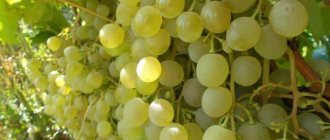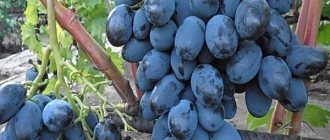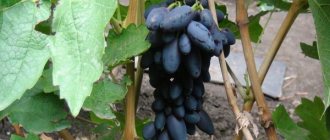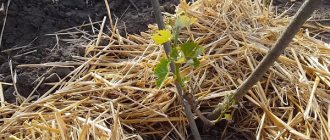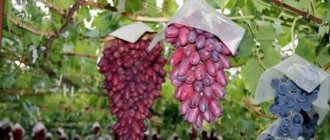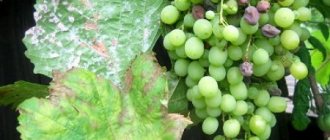Description of the Athos grape variety
The young vine of the Athos variety is brownish-reddish, with nodes of a more saturated shade. Grape shoots grow quickly, darken and become woody with age. The rounded leaves are medium-sized, dissected, with jagged edges, intense dark green color. On the inside there is inexpressive pubescence. The bisexual flowers of the Athos grape are well pollinated, ensuring an abundant harvest.
The conical, rather dense clusters are large, weighing from 700 g to 1.5 kg. A distinctive feature of the Atos variety is its lack of tendency to pea. Large, uniformly sized berries, 30-32 mm long, 22-23 mm in diameter, weight 10-12 g. The shape of Athos grape berries is oblong, finger-shaped or nipple-shaped, with an elongated top. The thick skin is dark blue, almost black, and is barely noticeable when eaten. The crispy, fleshy flesh is juicy, darkish, almost burgundy in color. The seeds are small, of the same size. Sweet berries attract with a harmonious, pleasant taste, which is offset by a slight sourness: the sugar content reaches 19%.
Important! The popularity of the Atos grape variety is based on the unpretentiousness of the vine, the attractive appearance of the bunches, early ripening and exquisite taste.
According to the description, Athos is a grape that stays in bunches for a long time. Only some gardeners mention a small number of fallen berries. The bunches will ripen in 95-100 days, by the end of July or beginning of August. The berries ripen together, almost all at the same time. The longer they stay in the sun, the sweeter they become, they do not crack, and they can raisin. Due to their thick skin, they are not affected by wasps, but they attract birds. The bunches tolerate transportation well and are stored in a cool room for some time.
The Atos variety is intended for desserts, but with a large harvest, juice, liqueurs, and compotes are prepared from it. Athos is not a wine cultivar. Although the berries are also used for a noble drink, which turns out to be aromatic and rich in taste if a significant portion of wine varieties are added to the wort.
The Athos grape vine grows vigorously, during the summer the shoots stretch up to 6-7 m. The plant is quite drought-resistant. It is also recommended to ration the harvest, although the bushes are powerful and can feed large volumes of fruit. The Atos variety propagates easily, the cuttings take root well. For the winter, the bushes are covered; the plant tolerates only light frosts - up to 23 ° C. According to the assessment, the resistance of Athos grapes to oidium and mildew reaches 7 points, but prevention against gray rot is necessary. It is enough to tear off excess leaves around the bunches to ensure ventilation.
Attention! Regular feeding of grapes ensures dense clusters, large berries and a pleasant taste.
Forum statistics
207034 Messages in 1634 Topics from 5593 Users. Latest user: Amaya Latest message: “Ripening dates are different...” ( Today at 07:25:15 ) Latest messages on the forum.
Now on the forum
36 Guests, 6 Users
Users in the last 15 minutes: Marshal, Alexander Vl., Mikhail77, ElenkaF, Tatyana B, Alex65 [Blocked] [Section Moderator] [Forum Moderator]
Maximum online today: 77 . All-time maximum online: 2758 (28 July 2021, 17:22:51)
Users who visited the forum in the last 24 hours
Total: 297
(Visible: 296, Hidden: 1) 1963, Marshal, Alexander Vl., Mikhail77, ElenkaF, Tatyana B, Alex65, Cherkessk, Elvira2017, Eugene, zsb, leonidych, vladimirM, yotmast, mers, Serg1707, SNovichek, hanter64, znakomij, Alexander K, Vardan, Sergey Fer, Anatoly Sivkov, Alexey V, Ilya 77, Andrey Gladilin, Tatyana A., Belgorodets, in Astrakhan, Oksana Kopp, sem_en, Vladimir 153, skier, Igor Viktorovich, slavalimon, Primorets, OlgaOs, SANYCH, 31rus, mystic69, DorontsovPeter, Andrey Tsvetkov, Buba, igor222, Andrey76, Elena Z, vlad51, Kenig, Nikolay Rex, Sergey 1965, Vladimir Buturlakin, DSW, psv1960, Dmitry 77, Vasily V., Vyacheslav03, Natalia Nikolaevna, Sergey Tashchiyan, Nikolay S., Igor Sergeevich, alexsandr, kvg, Pioneer, Ekaterina Polyanina, nicson7, Elena Aleshchenko, Alexander-ask-34, Verona, Igor F., Taker, Tikhiy, Henry, Yuri72, L.A.P., Yuri Gaivoronsky , Sergeevich, Sergey Chistokletov, Svetlana Streletskaya, Galinka, Alexey Deminov, Igor Naumov, Vyacheslav136, Gloomy, Katrin, AndSanych, Alexander Mikhno, Ded31, Oleg Filippov, Vladimir ++, Svetla777, Mikhail Alekseevich, Lydia58, ALEXANDER BRYANSKY, Vladimir-kanevsk aya , DIL, Amber7394, Marina Protasova, TITOVA LYUBOV, Linx, alexander66, Natalya M, Mikhail Fesenko, Amaya, Alexander71, Boris 1952, tsv, Maximilian, 25nata35, nadia, GALINA ANOKHINA, Igor_K, Alexander Kolesnikov, Ivan Levin, Pitko, weather forecaster , eSAa, cecet71, atseton, Alexander Smirnov, Vladimir Kostochkin, Vladimir Berdnikov, Gocha, pioneer-2, LeXa_KoT, Sergey 61, Sergey Yuryev, Erem, alexss, Evgeniy52, Skif, lomakin1969, Vladimir Kovba, dayton, Yuri Semyonov, N. A. Sokolov, Pavlentiy, Sa-shura, Volgogradka, Dmitry Anatolyevich, Grandfather Igor, Andrey Lis, Bublichenko Alexander M, Marina Krymskaya, stenlly2010, irahelm, Vyacheslav Vladimirovich, Vladimir Shilov, Aprel, Dmitry Badaev, gheo55, Yura, y_fed, rambo , Yagodka, Valentina Ivanovna, Kryn, oleg9f, DED2, Svetlana Korotina, Oleg Ivanovich delivered, Eduard., santra, L2k2m7n, Alexander48, Viknik, Andrey 31, m2d, Valery Rastorguev, Soshnin Yura, Amateur gardener, Galina, Vasily1111, gardener , marlin64, Salex, sergei, Sergey Ko, Ramiz, victor_, kosmos, potap05, Yuri 36, VitalySD, Inna161, Vova Kapran, Vladimir Shcherbinin, Valerie, niy1, cfibr, Andrey68, kulol3, Slavka, thanatos, Serzh1978, Realist, Artur53 , max2008-01, LOZA, AlexanderD, Grandfather Young, Natasha, Zayac, ketch, Rita, alx-74, Iv Iv, Alexander150, Igor K, Vasily Viktorovich, VeraNiK, kdm57, Veniaminovich, Boris Sokolyansky, therapist, Capricorn, 77volt, , vikbublik, neposny, Evgen, Victoria Aleksandrovna, Serezha 64, Wintel, Airbone, teri, Sergey Lomonosov, Khramov, serginio, Leonty Yarygin, Irina O., Ser, Nadezhda Grig, Lyubov S., netolya, Saisan, Alexey Agryzkov, Vadi , Zinaida, Vadim, Alexander Taganrog, Sukhononov Sergey, Snezhinets, Evgen_26, NAU_63, Masha_Sadovod, Gennady163, Krasnovlad1, Alexander Zinoviev, Vasily 53, Roman Fedorovich, Tis, Aleksey Sergeevich, Arnya, Zheka, Nurtas, Kradievska, 64nikolay64, Nick04, NickK 41, Liza , Valentina Medvedeva, Sergey43, Andrey S., Nikolay Lipunov, Mst, Vertuoz2, Vladimir VS, NatalyaMed, freesia, Kinna, Mikhail Michurinsk, alekcsan1, VALERY TAMB, Sasha57, MikhAf, Y_Azer, Andrey Beribesov, hunter1955, nut lover, Keys, Ivan Shmelev, Pestik, anton_slash, Nadymchanka, Sergey 31, Volgar, Pavel 64, Tatyana Volzh, Elektronik_t, Alexander 61, spotlight, Alexander Gai, Cheprak, Pirko Alexander, vladimirvrn, Antrikan, asun16
Pros and cons of the Atos variety
The vine is attractive for its abundant harvest and early harvest of beautiful clusters of dark berries. Judging by the photo and description of the Athos grape variety, it has many advantages:
- high yield and no peas;
- ripening of berries, which is close to 100%;
- early ripeness;
- transportability;
- excellent commercial performance;
- quality taste;
- unpretentiousness;
- resistance to many fungal diseases.
Among the disadvantages, it is noted that this is a vine for the southern regions. Severe frosts can destroy poorly sheltered Athos grape plants. It is also necessary to protect plantings of table grape varieties from infection with gray mold and attacks by feathered connoisseurs of delicious berries.
Diseases
As noted above, Athos grapes have relatively strong immunity, which protects it from oidium. But, alas, culture is not protected from a number of other diseases. In particular, gardeners often have to deal with such problems as:
- Anthracnose. This disease is caused by the fungus Gloeosporium ampelophagum. If your crop is infested with this pathogen, then you will notice brownish spots with a white edge covering the leaves of the plant. If no measures are taken, then the disease begins to grow rapidly. The spots become larger and the affected areas die. Soon the spots spread to the fruits, vines and flower stalks. The berries lose their taste and take on a terrible appearance. This disease occurs at high levels of humidity, especially in the spring.
- Mildew. This disease is also called downy mildew. The cause is the pathogen Plasmopara viticola. The disease appears in early summer. The first symptoms are the appearance of visible oily spots. Over time, white rashes begin to appear on the back of the sheet, somewhat similar to mold. If you do not fight mildew, the plant will soon begin to dry out and die. The disease most often appears in high humidity. If it rains heavily and the ambient temperature is in the range of 20-25 C, then these are ideal conditions for the growth of the fungus.
- Gray rot. The main problem of Athos grapes. The disease spreads to the green parts of the crop. After invasion by the fungus Botrytis cinerea, the green parts of the grapes become covered with a gray coating, which scatters spores for further damage. Spores are released on contact, that is, if you touch the plaque with your finger. If the summer turns out to be dry, then the disease will die after invading only a small area. But moisture, on the contrary, contributes to further damage to the crop.
- Black spot. This disease is caused by a fungus of the Deuteromycetes class. In summer, colorless spots appear on the shoots, which over time acquire a dark shade. If the invasion is not dealt with, then it begins to grow, and the affected areas rot and die. Gradually, the fungus moves to the green part of the plant. As in previous cases, the spread of the disease occurs in a humid environment.
These diseases are controlled with special fungicides.
Optimal growing conditions
The sun-loving Athos grape vine is planted in open areas. If the garden is located in the middle climatic zone, where there are strong winds and frosts, Athos vines are placed in the southern or southwestern direction of the garden plot. It is better to plant grapes under the protection of the wall of the house, retreating 70-90 cm. Picturesque vines with weighty tassels serve as a beautiful decoration and fill a corner of the yard with a subtle aroma during flowering. A distance of 1.2 to 2 m is left between the bushes. It is advisable to retreat more, since the vine grows quickly. Mandatory care includes watering, fertilizing, pruning shoots and crop rationing.
Planting and caring for Athos grapes
The variety is not capricious; even beginning winegrowers can take care of it.
Selection and preparation of a landing site
Atos grape seedlings are placed in the sun, under the protection of a dense high fence or building walls, if they decide to grow a variety that is not entirely frost-resistant in a temperate climate. Groundwater in the area should not rise above 1.5 m. It is recommended to prepare planting holes for successful grape growing several months in advance:
- when planting in April, add the substrate in October;
- for autumn - in May, June.
Dig a hole with a diameter of 80 cm and the same depth. A drainage of up to 10-15 cm made of gravel or ceramics with sand is laid at the bottom. For the substrate take:
- part of the top layer, the first 20-25 cm of soil;
- part of the humus;
- 500 g nitroammophoska;
- 1 liter of wood ash;
- 5 liters of peat, which retains nutrients in the substrate.
Landing rules
Athos grapes are planted in spring and autumn. Lignified seedlings are placed on the site from mid-April for a month. Cuttings are planted after the threat of return frosts has ceased - after May 20 until mid-June.
When placing a seedling in a hole that has already settled for 2-3 months, prepared soil, they first hammer in an iron rod for a vigorous bush, which will serve as a support for it for decades. On the other side of the pit there is a pipe for irrigation. This device has proven itself well in the southern regions, where the bush receives the necessary moisture by direct watering with warm water at the root.
Before planting, the lignified seedling is soaked in water with growth stimulants for 24-40 hours so that it is saturated with moisture. Selling organizations dig up seedlings in the fall, and in winter they are stored in basements. Therefore, gardeners stimulate the plant by adding honey to the water - 2 tbsp. l. for 10 l.
Advice! It is better to orient the seedling of vigorous grapes in advance with the direction of the trellis: when planting, the seedling is placed so that the buds are in the same plane as the supports.
The roots of the seedling are deepened by 40 cm. If the hole is freshly dug, by 35 cm, since the substrate will settle with the plant. A shoot with 4-5 buds is left on a 1-year-old woody seedling; the top is often cut off during spring planting. When it is already clearly visible that the two lowest buds are developing successfully, the shoot is shortened. If you leave all the buds to develop, the upper shoots will be more powerful, but they will grow high on the bush and will be difficult to cover for the winter.
Watering and fertilizing
The Athos variety is drought-resistant; the bushes are watered once every 7-10 days, based on the amount of natural precipitation. Grapes need moisture during the following periods:
- after a winter with little snow in dry April and May;
- in the stage of budding;
- in the flowering phase;
- at the end of June, at the beginning of July, when the berries grow;
- in October for moisture recharging.
In the first year of development, grapes are not fertilized - the seedling takes its nutrition from the substrate. The following spring, in April and before flowering, each plant is fed with a mixture of 10 g of ammonium nitrate, 5 g of potassium salt and 20 g of superphosphate, diluted in 10 liters of warm water. After flowering, fertilize with almost the same mixture from which saltpeter is removed. Before autumn water recharging, fertilize the bush with a solution of 30 g of potassium salt in a bucket of water.
Comment! Organic matter is applied to the grapes once every 3 years, digging grooves 50-60 cm long around the perimeter of the hole for humus. Next time the grooves are made on the other side.
Trimming and shaping
In the south, Athos grapes are formed into 4 branches; in more severe climates, 2 strong shoots are enough. In the fall, 2-3 eyes are left on them, which will produce branches next summer. The norm of eyes for an adult bush is 30-35, if the feeding area reaches 5-6 square meters. m. Every autumn, up to 6-8 buds are left on the shoots. As some gardeners write in reviews, Athos grapes do not need to be rationed. But even a tall vine will hardly feed more than 20 kg of berries, so it is better to remove excess clusters.
Preparing for winter
A peg is driven in near the autumn seedling, which will serve as a support for a plastic bottle that covers the top of the future bush. The seedling is covered with earth from above, then with snow in winter. In spring the cover is removed. For mature Athos grape vines, shallow pits are dug, where shoots are laid out on a bedding of cardboard or agrotextile and sprinkled with earth.
Agricultural technology
The variety does not have any special care requirements, but the basics of agricultural technology must be followed.
The variety is quite unpretentious, but do not ignore the simplest rules of agricultural technology:
- watering;
- weed removal;
- loosening;
- feeding;
- pruning;
- preventive treatment.
Features of watering
For watering it is convenient to use a drip irrigation system.
Early grape varieties require at least three waterings: autumn and two in spring and summer. The autumn drainage of the vineyard is called moisture-charging, since it provides the bush with the necessary moisture for the entire wintering period.
- In early spring, watering is important in case of a winter with little snow.
- Additional summer moisture is necessary during the period of bud break, flowering and fruit ripening. You should not be too zealous, otherwise the berries may crack and the root system of the plant may be damaged.
- When planting in rows, water should be poured into the furrows . In the case of classic planting, pour into the holes. Drip irrigation is considered the best method.
- Do not forget about loosening after each watering of the crop.
Pest treatment
The variety requires preventive treatment of the vine against gray rot with any fungicide.
Despite good resistance to diseases, you should not ignore basic preventive treatment measures.
The main danger is gray rot. This disease makes it impossible to store and transport the crop, and complete recovery of the crop takes a long time - 2-3 years.
To combat gray mold, fungicides are used - Topsin, Benleit and Penoknazol . Do not forget about providing the fruits with direct sunlight and fresh air. To do this, thinning of leaves is used.
To control birds, feeders with poison or more gentle means are used - fine mesh nets thrown over bushes .
Leaf rollers also pose a great danger to grape crops. As preventive measures, insecticides such as:
- DDVF;
- Karbofos;
- Gardona;
- Chlorophos.
Reviews of Athos grapes
Igor Petrovich Sinkov, 35 years old, Tikhoretsk
I have been growing Athos grapes for 4 years at the dacha. This season I received a bountiful harvest from my two vines. It was not in vain that my efforts to grow weak cuttings were wasted. I planted them in the spring; dry winds have already begun. I protected it from the sun with cardboard boxes, with a round hole cut out on top for ventilation. Two weeks later, when the bushes sprouted leaves, I removed the protection. Watering once a week was enough. The first time I fed it with organic fertilizer - a fermented solution of chicken manure in the furrows.
Anatoly Sergeevich Dolinykh, 56 years old, Rostov region
I purchased the Atos grape variety back in 2010. I also planted 2 bushes from cuttings, and they grew surprisingly quickly. Now I'm putting out vines in 4 branches. The trellises were oriented so that the grapes were illuminated by the sun almost all day. The lower branches spread at a height of 50 cm, the next tiers are placed 45-50 cm upward, to a height of 2.5 m. The clusters all ripen well, I hide them from birds in mesh bags. The variety is excellent, early, marketable.


